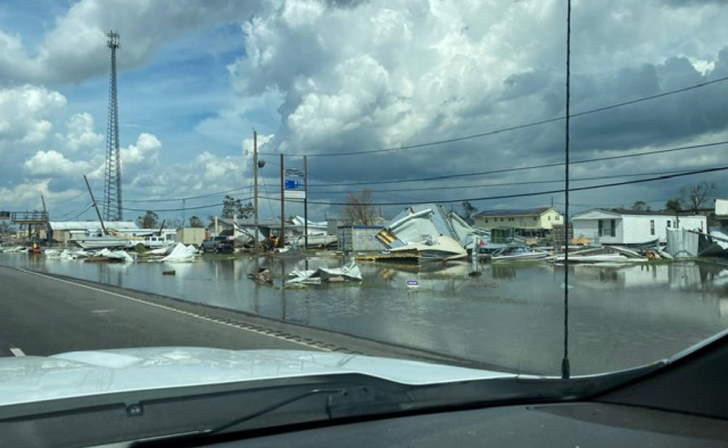Storm Season
NOAA Forecasts Above-Average 2024 Hurricane Season
IBHS reveals ratings for hurricane coast states

Roofing contractors in hurricane-prone locations should prepare for an above-normal season in 2024, according to the latest forecast from the National Oceanic and Atmospheric Administration.
Forecasters at the Climate Prediction Center say the 2024 Atlantic hurricane season, which goes from June 1 to Nov. 30, will have an estimated 17 to 25 total named storms. Of those, eight to 13 are said to become hurricanes (winds at 74 mph or higher), including four to seven major hurricanes at Category 3 or higher. Overall, there is an 85% chance of an above-average season.
“Of note, the forecast for named storms, hurricanes, and major hurricanes is the highest NOAA has ever issued for the May outlook,” said NOAA Administrator Rick Spinrad.
The NOAA notes they have 70% confidence in these predictions. Factors playing into the above-normal season include near-record warm ocean temperatures and reduced wind shear in the Atlantic Ocean, as well as the development of La Nina conditions in the Pacific.
Hurricanes are categorized mainly by their wind speeds, which can have devastating effects on rooftops, sometimes ripping whole buildings apart. But since 2013, 418 indirect fatalities have occurred, mostly from people returning too early to storm-ravaged sites, said National Weather Service Director Ken Graham.
“The dangers aren't over when the storm passes. And a lot of those fatalities are just clean up. Right? It's going out too early,” he said. “Please listen to those local officials. They know what they're talking about.”
Graham pointed out in regards to being prepared, the data shows that rapid intensification is a major concern. In the last 100 years, all Category 5 hurricanes have been those that rapidly intensified, and the average timeline for these intense storms is 50 hours, which isn’t much time for evacuations or last-minute preparations.
“You can't wait till the wait till the storm surfaces, because you may not have the time,” he said.

During a May 23 presentation on the hurricane season, officials commented on the difficulties people in Gulf states are facing with insurance, whether it is obtaining insurance or dealing with higher costs related to tropical systems. FEMA Deputy Administrator Erik A. Hooks said the agency is “well partnered” with state and local tribal partners in local communities in the Gulf Coast.
“There has been a heavy focus within the last few years, thankful for congressional appropriations, for mitigation dollars that have flowed to those Gulf communities as well for the entire response season and throughout the year, we rely on the Disaster Relief Fund. And so those appropriations for response would be available to those Gulf states,” said FEMA Deputy Administrator Erik A. Hooks.
Officials noted the best way to be ready for hurricane season is to prepare and stay prepared – advice that works well for both residents as well as contractors.
“Remember, it only takes one storm to devastate a community, and it's prudent to prepare now because once the storm is headed your way, it all happens so rapidly you won't have the time to plan and prepare at that point,” Spinrad said.
Hurricane Coast State Ratings
Earlier this year, the Insurance Institute for Business & Home Safety released the fifth edition of “Rating the States,” which evaluates building code adoption, enforcement and contractor licensing in the 18 states along the hurricane coastline from Texas to Maine.
IBHS conducts its Rating the States every three years to coincide with the building code cycle. It ranks each state on a 100-point scale by analyzing factors in the current code environment that influence windstorm resilience. A quarter of a state’s score is determined by that state’s regulations for on-site implementation and proficiency, as demonstrated by contractor and subcontractor registration, licensing, and continuing education.
This year’s ratings show that, while some states work to ensure homes are resilient, many others remain vulnerable.
“Most people trust their state, city, or town has rules or codes to ensure homes are built to be safe and strong,” said IBHS CEO Roy Wright in a written statement. “Yet, despite their proven effectiveness, less than 35% of Americans live in communities with an adopted modern building code.”
After two consecutive second-place finishes, Virginia topped the 2024 Rating the States rankings with a score of 96. IBHS notes it returned to the top spot after adopting the 2021 International Residential Code and improving training programs for code officials and contractors.
Florida, which has held the top spot since 2018 and matched its 2021 score of 95, is now behind Virginia in this year’s ratings. South Carolina — identified as the “state to watch” in the 2021 report — ranked third in this year’s list, and New Jersey followed in fourth.
Texas was third from the bottom of the list with a rating of 33, followed by Alabama at 30. The state with the lowest rating in this year’s report is Delaware at 23.
Mississippi had the biggest overall improvement since 2021, with IBHS saying it gained 15 points by requiring licensing, competency testing and continuing education for contractors. However, these requirements do not apply to roofers and the state, ranked 15th, is still in the bottom third of the ratings.
“The states in the lower third of the rankings have less than half the points of Virginia, with Delaware sitting an astounding 73 points behind,” said Wright. “In these states, the onus for protecting homes is squarely on homeowners, who must look to voluntary construction standards, like FORTIFIED, to ensure they’re ready for a storm.”
Looking for a reprint of this article?
From high-res PDFs to custom plaques, order your copy today!





.jpg?height=200&t=1724950853&width=200)
